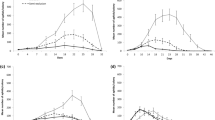Summary
Analysis of changes in numbers of the lime aphid, Eucallipterus tiliae L., reveals that there is an overcompensated density dependent factor acting within years, and an inverse density dependent factor acting between years. Because of its effect on the aphid's rate of development and reproduction the variation in temperature from year to year acts as a density disturbing factor.
There is no evidence from laboratory experiments to suggest that the quality of its food influences the numbers of the lime aphid. However, qualitative changes in the aphid following period of aphid abundance are shown to be important in the overcompensated density dependent response. The more prevalent insect predators influence the regulating process as they eat most of the aphids that remain after an aphid population has declined from a very high level of abundance. Their action results in a more overcompensated response than would occur in their absence.
Similar content being viewed by others
References
Clark, P.J., Evans, F.C.: Distance to nearest neighbour as a measure of spatial relationships in populations. Ecology 35, 445–453 (1954).
Dempster, J. P.: The population dynamics of grasshoppers and locusts. Biol. Rev. 38, 490–529 (1963).
Dixon, A. F. G.: Reproductive activity of the sycamore aphid, Drepanosiphum platanoides (Schr.) (Hemiptera, Aphididae). J. anim. Ecol. 32, 33–48 (1963).
—: Population dynamics of the sycamore aphid, Drepanosiphum platanoides (Schr.) (Hemiptera: Aphididae): Migratory and trivial flight activity. J. anim. Ecol. 38, 585–606 (1969).
—: Stabilization of aphid populations by an aphid induced plant factor. Nature (Lond.) 227, 1368–1369 (1970a).
—: Quality and availability of food for a sycamore aphid population. In: Animal populations in relation to their food resources, ed. by A. Watson, p. 271–287. Oxford: Blackwell Scientific Publications 1970b.
—: The role of aphids in wood formation II. The effect of the lime aphid, Eucallipterus tiliae L. (Aphidiae), on the growth of lime, Tilia×vulgaris Hayne. J. appl. Ecol. 8, 393–399 (1971a).
—: The life cycle and host preferences of th bird cherry-oat aphid, Rhopalosiphum padi L., and their bearing on the theories of host alternation in aphids. Ann. appl. Biol. 68, 135–147 (1971b).
— Wratten, S. D.: Aggregation, size and fecundity in the black bean aphid, Aphis fabae Scop. Bull. entomol. Res. 61, 97–111 (1971).
Hille Ris Lambers, D.: Polymorphism in Aphididae. A. Rev. Ent. 11, 47–78 (1966).
Lees, A. D.: The control of polymorphism in aphids. Advanc. Insect Physiol. 3, 207–277 (1966).
Llewellyn, M. J.: The ecological energetics of the lime aphid (Eucallipterus tiliae L.) and its effect on tree growth. Ph. D. thesis, University of Glasgow (1970).
Noble, M. D.: A simplified clip cage for aphid investigations. Canad. Ent. 90, 760 (1958).
Shaw, M. J. P.: Effects of population density on alienicolae of Aphis fabae Scop. II. The effects of crowding on the expression of migratory urge among alatae in the laboratory. Ann. appl. Biol. 65, 197–203 (1970).
Sluss, R. R.: Population dynamics of the walnut aphid, Chromaphis juglandicola (Kalt.) in Northern California. Ecology 48, 41–58 (1967).
Southwood, T. R. E.: Ecological methods. London: Methuen 1966.
Varley, G. C.: The concept of energy flow applied to a woodland community. In: Animal populations in relation to their food resources, ed. by A. Watson, p. 389–405. Oxford: Blackwell Scientific Publications 1970.
Author information
Authors and Affiliations
Rights and permissions
About this article
Cite this article
Dixon, A.F.G. The role of intra-specific mechanisms and predation in regulating the numbers of the lime aphid, Eucallipterus tiliae L.. Oecologia 8, 179–193 (1971). https://doi.org/10.1007/BF00345812
Received:
Issue Date:
DOI: https://doi.org/10.1007/BF00345812




